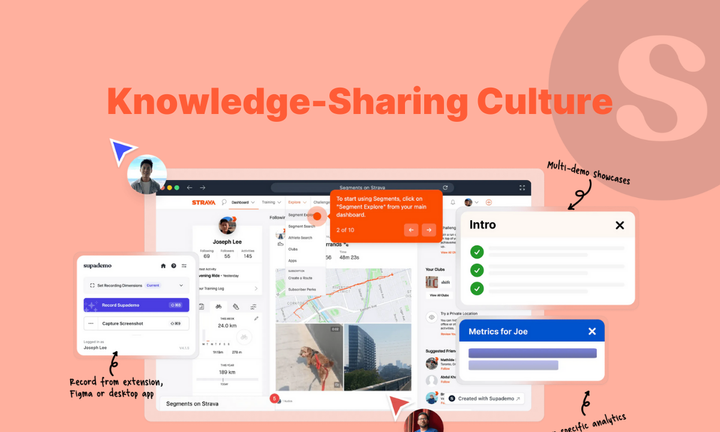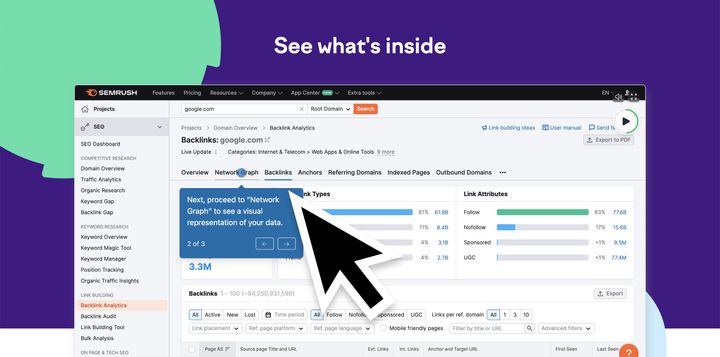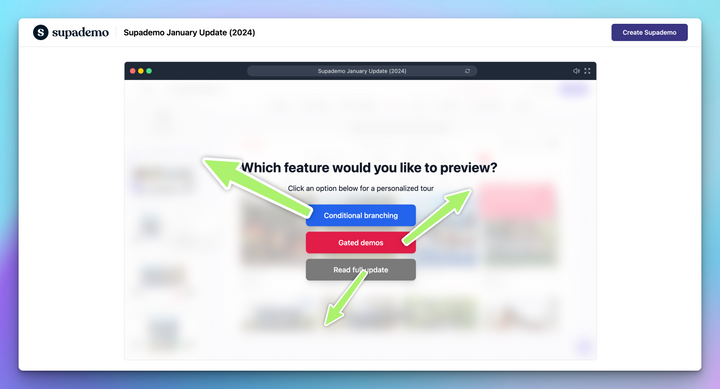On one North Sea drilling project, team leaders applied cost-saving tips learned from other experts in the company and saved an estimated $80 million on that single initiative. That’s the power of knowledge sharing at scale.
Yet most companies still don't get the importance of a knowledge-sharing culture.
According to Panopto, employees spend an average of 5.3 hours each week waiting for information from colleagues, costing large organizations over $42 million annually in lost productivity. The result? Delays, duplicated work, and decisions made in the dark.
To help you avoid this, in this guide, we’ll break down how to build it, where teams go wrong, and the tools to help you build your own knowledge-sharing culture.
Let's get into it.
What is knowledge sharing?
Knowledge sharing is the process of passing information, skills, and insights between people in a company. It turns individual know-how into collective understanding that teams can apply in real time.

There are two kinds of knowledge typically shared in organizations.
- Explicit knowledge is structured and easy to document, like SOPs, playbooks, or training manuals.
- Tacit knowledge, on the other hand, is personal and experience-based. It includes judgment calls, mental models, and lessons learned through hands-on work.
While often confused with knowledge management, the two are not the same. Knowledge sharing is about behavior and culture - conversations and mentorships that encourage ongoing exchange.
Knowledge management is more about systems and structure, focusing on organizing and storing information through wikis, CRMs, and internal databases.
| Category | Knowledge Sharing | Knowledge Management |
|---|---|---|
| Focus | Behavior and culture | Systems and structure |
| Goal | Improve collaboration and innovation | Organize and retain organizational knowledge |
| Format | Informal, ongoing conversations and tools | Formal processes, documentation, databases |
| Example | Peer-to-peer demos, mentorships | Wikis, knowledge bases, CRMs |
Benefits of a knowledge-sharing culture
When knowledge flows freely within a company, teams work faster, make better decisions, and feel more connected. Here are some of the most valuable benefits of building a culture around sharing what you know:
Faster onboarding and training
Now imagine this instead:
Before knowledge sharing:
- Manual 1:1 sessions with managers.
- Repetitive Slack Q&As.
- Onboarding stretched over 5–6 weeks.
After knowledge sharing:
- Self-serve process guides in Notion.
- Supademo walkthroughs for workflows.
- Peer-shared best practices.
- Productive in under 3 weeks.
Adrian Nikolov, Head of Content Marketing & SEO at MobiSystems, shared how his team improved onboarding using this exact approach:
"We overhauled our onboarding by turning every team's processes and common tasks into a structured, easy-to-search knowledge base using Notion. For the content team alone, onboarding used to take close to 6 weeks, with lots of repetitive questions, lost time, and Slack overload.
Now, new hires are fully contributing to live campaigns within 2.5 to 3 weeks. We've cut down repetitive training time by 40%, and in our last two quarterly surveys, new employees cited 'access to knowledge' as one of the top three reasons they felt successful early."
More innovation, less duplication
When internal knowledge is easy to access and repurpose, teams stop reinventing the wheel and start focusing on what matters: solving new problems. That’s the real strength of a knowledge-sharing culture: it removes friction from both the creative and execution process.
Instead of rewriting documents, re-running tests, or fixing issues that others have already resolved, teams can build on existing insights.
Kevin Moore, CMO of WalterWrites.ai shared how his team embraced this mindset:
"We replaced our traditional content briefs with 'context libraries' - searchable repositories where every successful campaign includes not just the final assets but also the reasoning behind every creative decision. When launching new campaigns, teams can instantly access why specific headlines worked, which emotional triggers resonated, and what A/B tests revealed.
This approach cut our campaign development time by 60% because teams aren't starting from scratch or repeating failed experiments."
Improved cross-functional alignment
One of the biggest blockers to alignment is that each team operates with a different version of the truth. Sales might pitch one feature while marketing promotes another. Product ships something new, but support isn’t looped in. That disconnect happens when critical context doesn’t reach the right teams at the right time.
Here’s what misalignment looks like and how knowledge sharing solves it:
| Function | Without Knowledge Sharing | With Knowledge Sharing |
|---|---|---|
| Sales | Pitches outdated features | Pulls updated GTM messaging from shared demo hub |
| Support | Escalates repeat issues | References annotated demo on known workarounds |
| Marketing | Builds assets off assumptions | Syncs messaging with product docs and sales notes |
| Product | Ships silently—others catch up later | Shares release notes via demo libraries & Slack |
A culture of knowledge sharing solves this by turning tribal knowledge into shared reference points—accessible to everyone, asynchronously.
Colleen Barry, Head of Marketing at Ketch, emphasized the importance of shared knowledge in high-stakes environments:
"At Ketch, privacy is a fast-moving space and if your GTM team isn't in sync with legal, product, and support, you're in trouble. Because we've invested in shared documentation and async updates, especially for new regulations or partner integrations, we've been able to turn around launches faster than competitors.
In one case, we responded to a major EU policy update 10 days faster than a key competitor by reusing learnings from a similar California update the year before."
Better decision-making
Strong knowledge-sharing habits give teams the confidence to act quickly without waiting for approvals or repeating past mistakes. When people have access to what’s already worked (or failed), they make sharper decisions and move faster.
Instead of asking, “Has anyone dealt with this before?”, high-performing teams build systems where the answer is already documented, searchable, and accessible.
Josh Howarth at Exploding Topics puts it well:
"We tag every resolved support ticket with the information that resolved it, whether that's a Loom video, phone call, or internal document. Over time this database turns into your source-of-truth for customer issues.
Customer support teams shouldn't feel like they're reinventing the wheel every time they're contacted. Repeated interactions need repeatable resolutions, and you only get there through knowledge sharing."
Stronger employee retention
When employees feel like their knowledge is valued and when they can access what others have shared, they’re more likely to stay. A culture of open documentation and shared learning not only supports productivity but also builds a sense of belonging and confidence.
In fact, companies with strong learning cultures enjoy 57% higher retention rates compared to those without them.
Instead of relying on one-off conversations or scrambling for answers, new hires can ramp up with clarity. Seasoned employees see their contributions reused and appreciated, which reinforces their value to the team.
Here's how it looks in practice:
| Knowledge Practice | Retention Benefit | Example |
|---|---|---|
| Interactive onboarding walkthroughs | Boosts clarity for new hires and reduces early-stage frustration | Supademo |
| Reusing internal documentation | Signals appreciation for team input and avoids redundant work | Notion or Confluence |
| Accessible demo libraries | Empowers employees to learn independently, at their own pace | Supademo Libraries |
Asawar Ali, Marketing Manager at Cadillac Accessory, shared how they tackled this head-on:
“We created 47 interactive training modules, 156 process documentation files, and 23 video walkthroughs that cover everything from technical specs to client comms. The knowledge base eliminates the ‘drinking from a fire hose’ experience that previously overwhelmed new members.
As a result, employee retention went from 78% to 91% after 18 months, which I attribute primarily to reduced frustration and faster competency gain.”
How to build a knowledge-sharing work culture
Creating a knowledge-sharing culture doesn’t happen by chance; it’s built through habits, tools, and intentional design.
Whether you're onboarding new hires, scaling cross-team alignment, or reducing repetitive work, these practices will help you turn scattered insights into shared assets.
Here's how high-performing SaaS teams do it:
1. Lead by example
A report by TalentLMS and SHRM found that 76% of employees say training is essential to their job, yet only 32% get the knowledge they need from their managers. Leadership-led transparency can close that gap and build trust from day one.
This gap highlights a key truth: if leaders aren’t sharing what they know, no tool or policy will build a knowledge-sharing culture. When managers consistently document decisions, walk through project outcomes, or openly share mistakes, it sends a clear message—knowledge is meant to circulate, not stay siloed.
That kind of visibility sets the tone for how teams work, grow, and trust each other.
2. Make documentation effortless
If sharing feels like a chore, it won't happen. The key is integrating it into the flow of work, not making it an extra step.
That means choosing tools that help teams capture and document procedural knowledge as they go, without needing to switch contexts, hunt for templates, or record the same walkthrough five times. The right stack can make knowledge sharing nearly invisible to the person doing it, while still keeping it useful for everyone else.
Here are two tools that teams use to make process documentation seamless and repeatable:
Supademo
Supademo enables teams to turn internal workflows into interactive product walkthroughs. It supports rich annotations, branching flows, voiceovers, and multi-language support, making even complex processes easy to explain, scale, and repeat.
Teams can embed demos in Notion, Confluence, Framer, Gitbit, or support hubs for maximum visibility.
Companies like ReelDx have scaled internal enablement with Supademo, training over 100 clinicians and saving 12+ hours per month, which adds up to 100s of hours saved annually.
Notion
Notion gives teams a flexible, centralized space to create and organize knowledge—whether it's SOPs, project retros, or onboarding guides. Its block-based editor supports rich media, embeds, checklists, and version history, making it easy to capture both structured documentation and informal insights.
Teams can organize content by topic, function, or use case, and tag collaborators to keep context alive.
The first internal knowledge base dates back to Xerox PARC in the 1970s. Engineers began informally documenting fixes for copier issues laying the groundwork for enterprise knowledge management today.
3. Encourage asynchronous sharing
Async communication ensures that knowledge is preserved and discoverable, not lost in meetings or Slack scrollbacks.
A 2023 Microsoft Work Trend Index found that employees spend ~57% of their time communicating and only 43% creating.
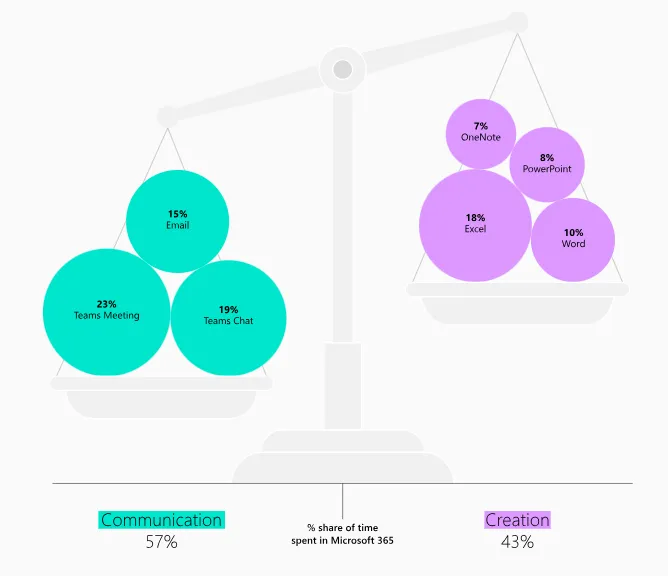
By shifting to async updates like annotated Loom videos or structured demo libraries, teams free up time while still capturing critical insights. People can contribute at their own pace, revisit walkthroughs when needed, and stay aligned without the overhead of live meetings.
4. Reward and recognize contributors
According to Gallup’s 2025 State of the Global Workplace report, companies with highly engaged employees, those who feel included and recognized experience 59% less turnover and 41% lower absenteeism.
One way to build this level of engagement? Celebrate knowledge sharing. At Gifted.co, marketing and sales teams run quarterly shoutouts to spotlight teammates whose internal documentation helped close deals faster or streamline campaign launches.
The results: stronger trust across departments, shorter ramp-up time, and fewer repetitive support queries.
5. Build reusable libraries, not one-offs
Too often, teams end up recreating the same walkthroughs, campaign decks, or internal explainers, leading to wasting time and creating inconsistency. A stronger approach is to treat knowledge like infrastructure: build once, reuse everywhere.
To do this well, you need tools that support modular, easily searchable, and updatable content libraries, ones that allow teams to scale documentation without starting from scratch each time. Here are a couple of tools to save your time:
Supademo libraries
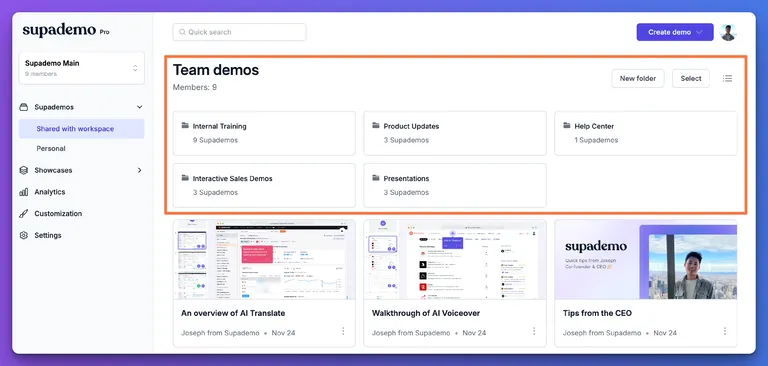
Supademo makes it easy to build organized, reusable demo libraries tailored to different teams or use cases like support, onboarding, internal process standardization or sales enablement. Within each workspace, teams can group demos into folders and subfolders, making it simple to manage knowledge by department, feature, or process.
For broader sharing, Supademo’s showcase collections let you curate multiple demos into a single branded page that’s searchable, categorized, and accessible via one link.
Here's what a Showcase collection looks like -
Spare Labs' Product Managers were drowning in release documentation—creating separate training materials, internal demos, and customer explainers for every feature launch. This "check-the-box" process consumed time better spent on strategic product work.
Supademo solved this with interactive walkthroughs that work across all touchpoints. One walkthrough now serves multiple purposes: onboarding, training, and customer demos.
Result: 50+ hours saved monthly, faster releases, and consistent messaging everywhere.
Confluence
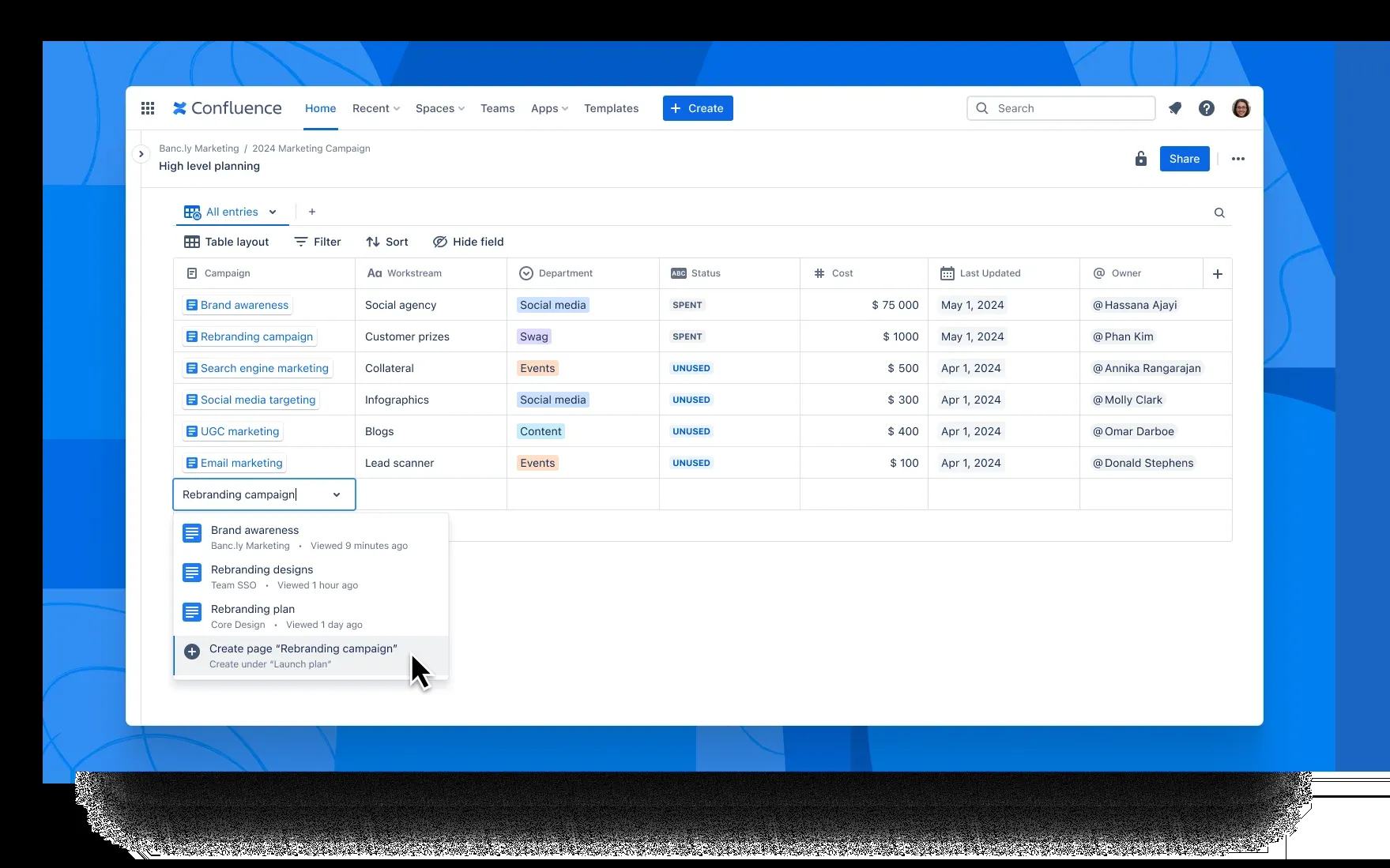
For structured documentation, Confluence remains a go-to for many SaaS teams. It allows you to pair long-form process docs with checklists, diagrams, and embedded videos.
It's ideal for step-by-step SOPs that require more context or collaboration. When linked with demo tools like Supademo, it becomes a powerful knowledge-sharing hub.
6. Audit and update often
Smart teams treat documentation audits like product releases. They assign content owners, set quarterly review cycles, and track metrics that matter: How often are docs accessed? Which articles generate the most support tickets? Where do new hires get stuck?
Make sure that you factor in the necessary resources and time to get it all done. If not, you risk being overwhelmed with too much change for too little gain.
Examples of knowledge-sharing organizations
Some companies don’t just talk about knowledge sharing, they operationalize it. Here’s how leading B2B SaaS teams are turning shared knowledge into daily momentum:
1. Atlassian
At Atlassian, open collaboration is part of their DNA. All Confluence pages and internal blogs are open by default, allowing employees to discover project updates, strategic decisions, or peer insights without having to request access.
This transparency nearly eliminates informational bottlenecks, new hires can self-serve answers from day one, and veterans stay aligned without manager intervention.
2. GitLab
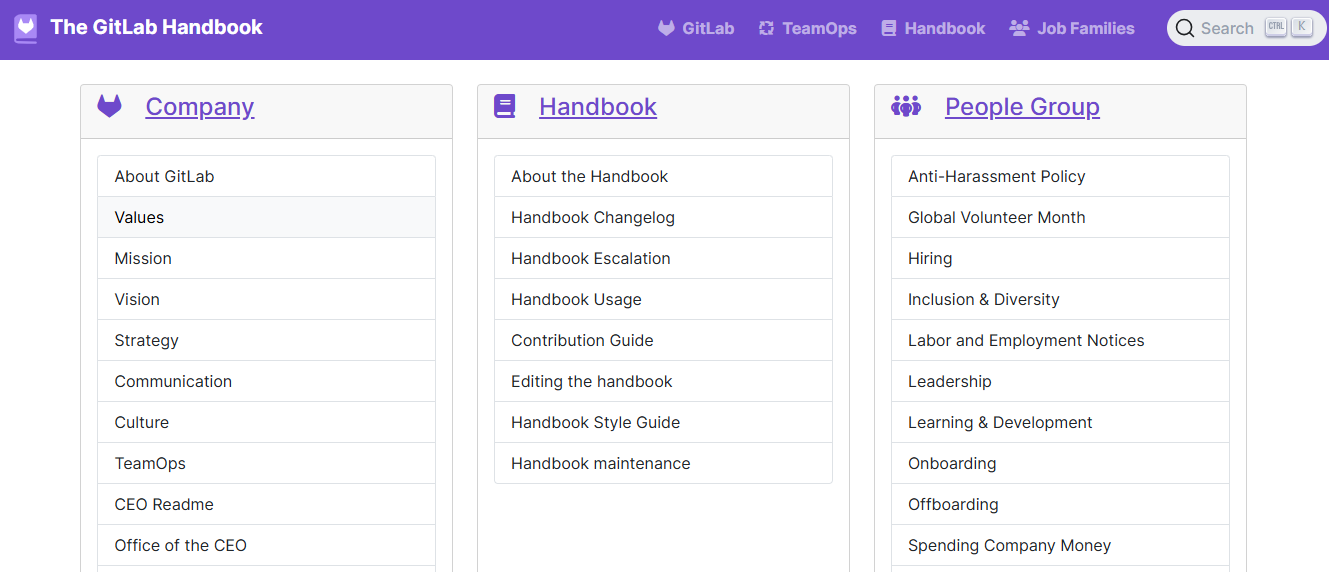
One of the earliest remote-first companies, GitLab has made documentation the heartbeat of its operations. Their public handbook, spanning 2,000+ pages, is collaboratively updated and version-controlled, covering everything from onboarding to engineering principles to compensation models.
Every team is empowered to contribute, and every page has a clear owner. The result: decisions are transparent, processes are consistent, and knowledge is always accessible, even across time zones.
3. Zapier
Zapier operates as a fully remote, async-first company where knowledge sharing is embedded into daily workflows. Their approach combines distributed documentation, AI-powered training, and structured mentorship to make knowledge capture automatic rather than optional.
The engineering team documents everything from development setup to code reviews in their shared Quip knowledge base. Their multi-week onboarding blends tools like Sapling and Lessonly with live sessions, creating a cohesive learning experience that works across time zones.
What sets Zapier apart is their "work in public" philosophy. Team members link Slack discussions to shared pages and document decisions in writing before taking action. This approach makes institutional knowledge searchable and accessible to everyone, regardless of when or where they work.
4. Supademo
At Supademo, we don’t just build interactive demo software; we use it across every function to scale internal knowledge. As a lean, async-first team of 10 supporting over 80,000 users globally, speed and clarity are critical. That’s why we’ve built our entire knowledge-sharing system using our own product.

From onboarding new hires to rolling out feature updates, we “dogfood” Supademo to document workflows, validate ideas, and communicate cross-functionally.
For example, instead of relying on repeated Slack explanations or meetings, we create clickable walkthroughs with voiceovers and branching flows that make complex processes instantly understandable.
Using Supademo internally helped us increase product activation by 20% and reduce time-to-value by 39%. Our GTM and support teams now rely on Supademo libraries to keep knowledge discoverable and consistent, without back-and-forth or Zoom calls.
Common challenges to knowledge-sharing
Even well-intentioned teams hit roadblocks when building a knowledge-sharing culture. Here are some of the most common:
- Tribal knowledge stays undocumented: When critical know-how lives in someone’s head, it becomes hard to access, especially for new hires or cross-functional teammates.
- No time to document: Teams move fast, and creating manuals or explainer docs feels like extra work. Without lightweight tools, knowledge stays scattered.
- Lack of self-serve systems: If teammates need to ask someone every time they’re stuck, knowledge-sharing doesn’t scale. Tools like Supademo let teams create quick, interactive walkthroughs that reduce hand-holding.
- Low visibility and discoverability: Docs buried in Slack threads or outdated wikis don’t help. For knowledge to flow, it needs to be easily searchable and embedded where people work.
Use Supademo for knowledge-sharing
Knowledge sharing culture isn’t just about having a wiki or hosting training sessions—it’s about creating habits, workflows, and tools that make sharing second nature. When knowledge is easy to capture, find, and reuse, teams move faster, stay aligned, and build on each other’s insights instead of starting from scratch.
That’s exactly why we built Supademo. From onboarding walkthroughs to internal process guides, Supademo makes it easy to turn complex workflows into interactive, reusable demos.
If you want to reduce ramp-up time, scale internal enablement, or simply stop answering the same questions on Slack, it might be time to see how Supademo can help.


